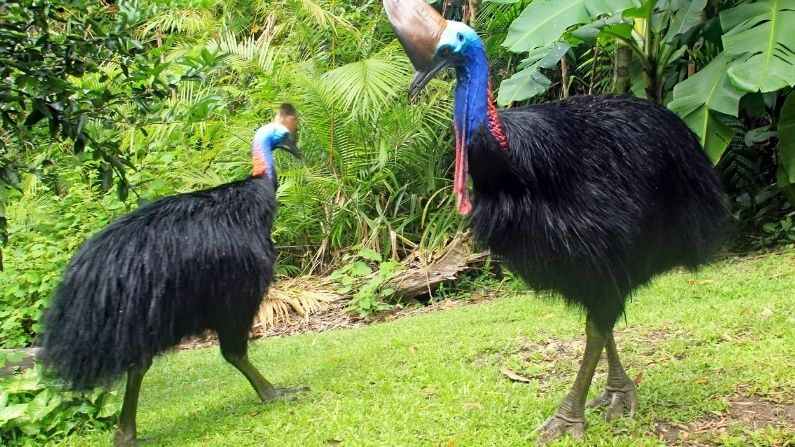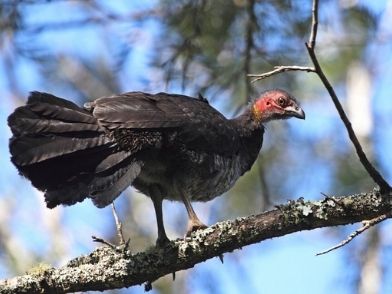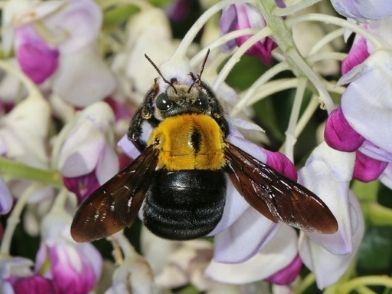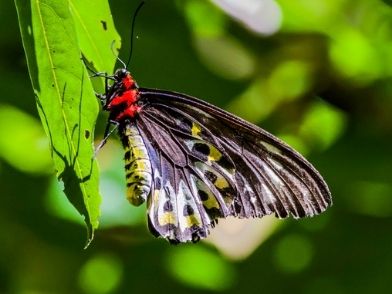Southern cassowary
© Greg Miles
The southern cassowary (Casuarius casuarius johnsonii) is the largest fruit-eating bird in the world. It is native to the tropical forests of Papua New Guinea, nearby islands and north-eastern Australia. The southern cassowary is an important rainforest gardener, spreading the seeds of rainforest trees. Sometimes the seeds are so large that no other animal can swallow and disperse them.
Quick facts
COMMON NAME:
Southern cassowary
ALSO KNOWN AS:
Double-wattled cassowary
SCIENTIFIC NAME:
Casuarius casuarius johnsonii
RECOVERY PLAN:
Recovery Plan for the Southern Cassowary 2007
Casuariidae
NATIONAL CONSERVATION STATUS:
Endangered
QLD CONSERVATION STATUS:
- Wet Tropics (southern population): Endangered
- Cape York populations (northern): Vulnerable
Did you know?
The southern cassowary is Australia’s heaviest flightless bird, but the emu is taller.
 © Lorraine Harris
© Lorraine Harris
Threats to southern cassowaries
- Loss, modification and fragmentation of habitat (serious reductions due to land clearing for farming, urban settlement and other development) in the Wet Tropics population on the Atherton Tableland and the coastal lowland and floodplains.
- Habitat degradation — invasion of weeds.
- Vehicle strikes.
- Dog attacks — juveniles and sub-adults are most affected. particularly in areas of residential development or where pig hunting is common even within protected areas.
- Human interactions — hand-feeding cassowaries has many implications:
- They may become dependent; when the food source is removed, they may starve.
- Hand-feeding near roads encourages them to return to areas where the likelihood of vehicle strikes is increased.
- Hand-feeding in urban areas makes them more susceptible to vehicle strikes and dog attacks.
- Pigs — may compete with cassowaries for food, eat cassowary eggs and modify habitat, but the significance is not demonstrated.
Home range
- Home range fluctuates, depending on the availability of food and mating season.
- Home range is estimated to be between 0.52km2 to 5km2 in coastal lowlands, but up to 12km2 in upland regions.
- Home ranges overlap both within and between the sexes, though the overlap between males and females is greater.
- Females’ home ranges usually overlap with those of several males.
- They only exclude other birds during the mating season when they can aggressively defend a mating territory.
Distribution
- Found in north-eastern Australia, Papua New Guinea and the Aru and Seram Islands.
- Cassowaries are found in three broad populations in north-eastern Australia:
- Cape York (far northern population): far northern Cape York Peninsula, centred on the much less extensive vine forests of Lockerbie and McHenry Uplands. The Lockerbie Scrub population is possibly extinct with no cassowary having been seen there since the early 1980s.
- Cape York (northern population): the vine forests of the McIlwraith and Iron Ranges.
- Wet Tropics (southern population): extends from Big Tableland, south of Cooktown to Paluma, north of Townsville. Distribution of the Wet Tropics population is naturally fragmented but has been reduced due to forest clearing on the Atherton Tableland and coastal lowlands. Currently, 89 per cent of the remaining habitat is in protected areas such as national parks and the Wet Tropics World Heritage Area.
Description
The cassowary forms part of a group known as ratites — large, flightless birds also including the emu, rhea, kiwis and ostrich. There are three species of cassowary: dwarf or Bennett’s cassowary (C. bennettii, with two subspecies); northern or single-wattled cassowary (C. unappendiculatus), both found in Papua New Guinea; and the southern cassowary, the only one found in Papua New Guinea and Australia.
Adult cassowaries are striking in appearance, with a tall brown casque (helmet) on top of the head, a vibrant blue and purple neck, red wattles and glossy black plumage. The purpose of the casque is unknown, but hypotheses include that it indicates dominance, protects the bird’s head when running through the forests (unlikely given it is quite fragile), helps keep the head warm and shed water in its wet habitat, and aids in hearing the low vibrating sounds made by other cassowaries. They possess small vestigial ‘wings’ with 5–6 bare quills and a long claw at the tip of the wing.
Southern cassowaries can grow to a height of 2 m, with males weighing up to 55 kg and females up to 76 kg. Each foot has three claws, better described as nails, with the medial, blade-like nail reaching up to 120 mm in length.
Cassowary chicks differ in appearance, with a striped brown and cream pattern. After 3 to 6 months, the stripes fade to the brown sub-adult plumage. This is retained until 12 to 18 months of age after which the bird begins to take on adult characteristics. Maturity is reached at 3.5 years of age for females and 2.5 years for males.
Signs
- Large dung piles:
- full of seeds but may also contain invertebrates and plants.
- most visible on rainforest walking tracks and roads.
- Three-toed footprint in soft soil or mud (approximately 180 mm for adults).
- Deep rumbling sound used to indicate presence and response to threats.
Habitat
- Tropical rainforests of north-eastern Queensland, Papua New Guinea and Seram and Aru islands.
- Also found in melaleuca swamps, mangrove forests, and sometimes grassland, savanna and palm forest not far from rainforest vegetation.
Life history
- Females and sub-adults are usually solitary, while males are frequently with chicks or young sub-adults). They are generally intolerant of other cassowaries except during mating and when fallen fruit is abundant.
- Females appear socially dominant.
- Life span of approximately 30 years in the wild and between 18 to 50 years in captivity.
Ecology
Breeding
- Mating season is from early June to September.
- Females may mate with more than one male in the season.
- Females lay three to five olive green eggs between June and October.
- Male incubates eggs for approximately 50 days.
- Male raises chicks alone.
- After approximately 9 to 18 months, with the onset of the next breeding season, the juveniles leave the male and begin to fend for themselves.
Food
- Primarily fruit, known to feed on the fruits of more than 240 plant species.
- Will consume invertebrates, plants, fungi, and carrion, as well as small vertebrates when available.
- Cassowaries play an important role in the ecology of rainforests. They are one of only 4 seed-dispersing animals that can disperse the seeds of large (up to 6 cm in diameter) rainforest fruits, and can do this over longer distances than the other dispersers of large seeds.
- Consume an average of 2.9 kg of fruit per day in captivity.
Recovery actions
- Recovery Plan for the Southern Cassowary 2007
- Actions to secure long-term protection of cassowary populations.
- Includes improving the protection of habitat and corridors, minimising road kills and dog attacks, establishing a monitoring program in key habitats, and involving the community.
- Approximately 89 per cent of habitat in the Wet Tropics population is protected in national parks and the Wet Tropics World Heritage Area and additional areas are being added.
- Residents in local cassowary regions are creating nurseries of cassowary food plants so rainforest trees can be planted to replace cleared land, and corridors can be planted to join remaining patches of vegetation.
- Road signs and traffic calming devices indicate cassowary habitat and areas where cassowaries may crossroads, especially in the Mission Beach area.
Overall outlook
- Cassowary populations in the Wet Tropics have a positive future given the high proportion of their remaining habitat protected to a high level.
- As long as habitat can be maintained, and vehicle strikes, dog attacks and human interactions can be controlled, the Wet Tropics population is likely to have a good long-term outlook.
- The far-northern Cape York population is less secure and thus more likely to become extinct due to its tiny area of occupancy.
- The northern population currently faces fewer pressures but occupies a smaller area and appears to be at a lower density, suggesting that any increase in threats will have a more rapid and severe impact.
More information
Publications & papers
-
Bradford, MG, Dennis, AJ, Westcott, DA, (2008). Diet and dietary preferences of the southern cassowary (Casuarius casuarius) in North Queensland, Australia. Biotropica, 40: 338-343.
-
Bradford, MG and Westcott, DA (2010). The consequences of southern cassowary (Casuarius casuarius, L.) gut passage and deposition pattern on the germination of rainforest seeds. Austral Ecology. 35:325-333.
-
Buosi, P. & S. Burnett (2006). The Southern Cassowary (Casuarius casuarius johnsonii): Review of Values and Threats in the Wet Tropics Bioregion, Queensland. A report for DEH. Queensland: Natural Resources Assessments Environmental Consultants.
-
Dennis, A.J. and Westcott, D.A. 2007. Estimating dispersal kernels produced by a diverse community of vertebrates. Pp 201-228. In: Dennis, A.J., Schupp, E.W., Green, P.J. and Westcott, D.A. 2007. Seed dispersal: Theory and its Application in a Changing World. CAB International. United Kingdom.
-
Garnett, S. Szabo, J. and Dutson, G. 2011. The Action Plan for Australian Birds 2010. CSIRO Publishing, Melbourne.
-
Green, R.J. 2007. Refining the conservation management of seed-dispersing frugivores and their fruits: Examples from Australia. Pp 579-598. In: Dennis, A.J., Schupp, E.W., Green, P.J. and Wescott, D.A. 2007. Seed dispersal: Theory and its Application in a Changing World. CAB International. United Kingdom.
-
Kutt, A.S., King, S., Garnett, S.T. and Latch, P. 2004. Distribution of cassowary habitat in the Wet Tropics bioregion, Queensland. Technical Report, Environmental Protection Agency, Brisbane.
-
Latch, P. (2007). Recovery plan for the southern cassowary Casuarius casuarius johnsonii. [Online]. Report to Department of the Environment, Water, Heritage and the Arts, Canberra. Environmental Protection Agency.
-
Moore LA (2007). Population ecology of the southern cassowary Casuarius casuarius johnsonii, Mission Beach north Queensland. J. Ornithology 148: 357-366.
-
Westcott, DA, Bentrupperbaumer, J, Bradford, MG and McKeown, A (2005). Incorporating disperser movement and behaviour patterns into models of seed dispersal. Oecologia 146: 57-67
-
Westcott, DA, Dennis AJ, Bradford, MG, McKeown, A, Harrington, GN (2008). Seed dispersal processes in Australia’s Wet Tropics rainforests. Pp 210-223 in, Stork N and Turton S (eds), Living in a dynamic tropical forest landscape. Blackwell Publishing, Malden.
-
Westcott, DA, Setter, M, Bradford MG, Setter, S, McKeown, A (2008). Dispersal of pond apple seeds by the southern cassowary: ecological interactions between a threatened and a threatening species. Diversity and Distributions 14: 432-439.
Websites
The following websites provide additional information about cassowaries.
- Qld Department of Environment and Science
- Birdlife International
- Wet Tropics Management Authority
- Department of Environment and Energy (Species Profile and Threats Database (SPRAT))




